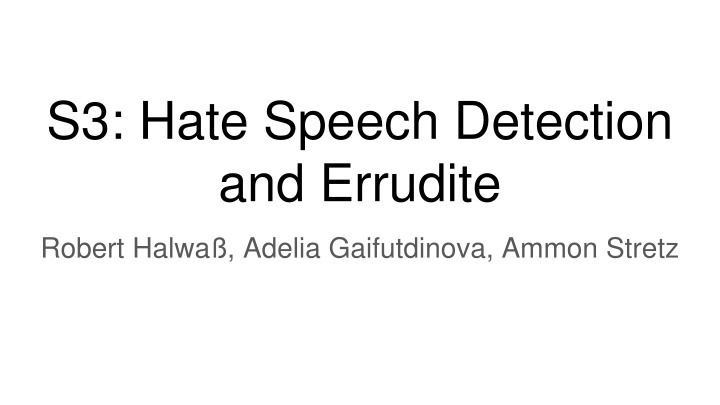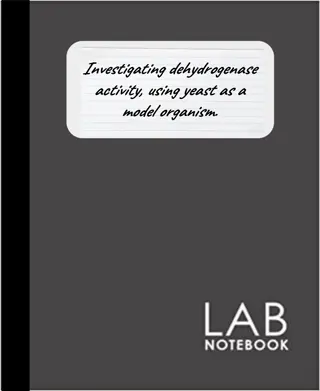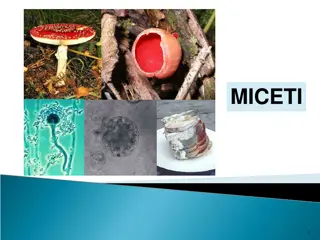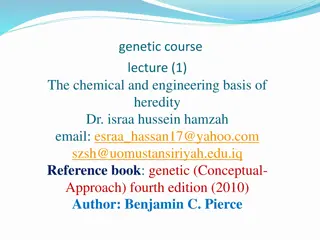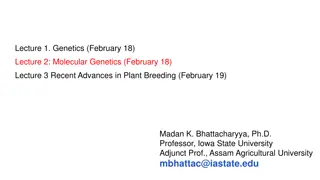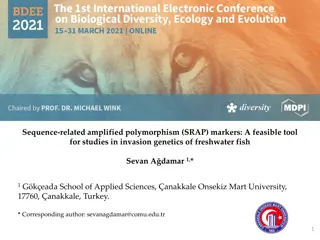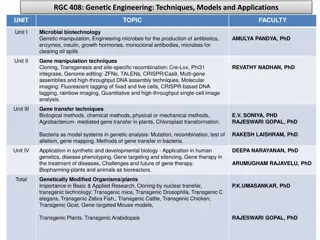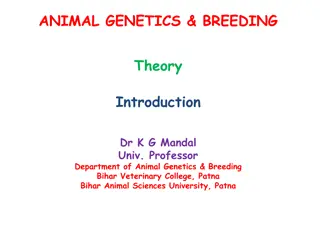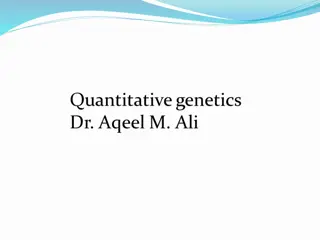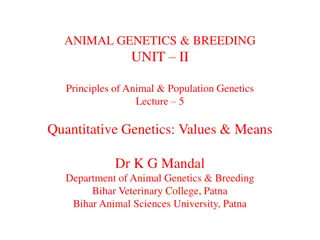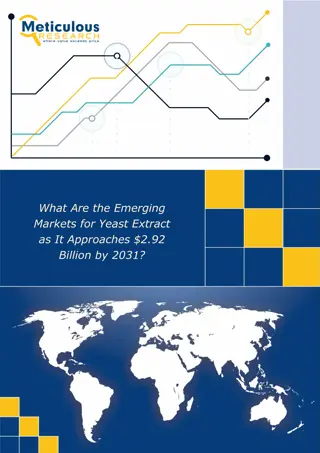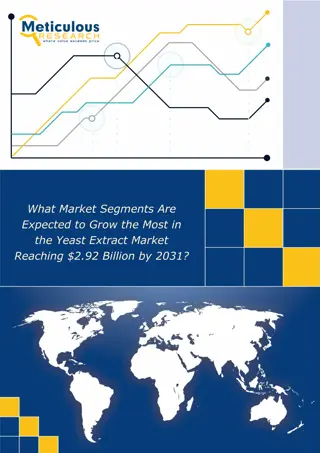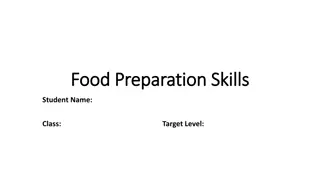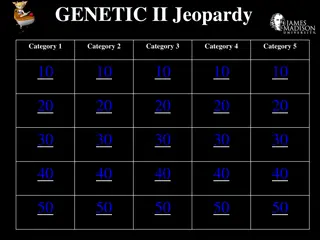Unraveling Yeast Genetics
Yeast, a unicellular fungus, serves as a valuable model organism for genetic analysis with its unique reproductive modes and genetic complexity. It offers a convenient system for studying gene regulation, protein structure-function relationships, and more. The versatile features of Saccharomyces cerevisiae make it ideal for exploring fundamental biological processes. Its nuclear genome contains 16 chromosomes, and it provides insights into eukaryotic genetics. Explore the growth patterns, genetic manipulation, and life cycles of yeast for an in-depth understanding of this powerful research tool.
Uploaded on Mar 04, 2025 | 0 Views
Download Presentation

Please find below an Image/Link to download the presentation.
The content on the website is provided AS IS for your information and personal use only. It may not be sold, licensed, or shared on other websites without obtaining consent from the author.If you encounter any issues during the download, it is possible that the publisher has removed the file from their server.
You are allowed to download the files provided on this website for personal or commercial use, subject to the condition that they are used lawfully. All files are the property of their respective owners.
The content on the website is provided AS IS for your information and personal use only. It may not be sold, licensed, or shared on other websites without obtaining consent from the author.
E N D
Presentation Transcript
S3: Hate Speech Detection and Errudite Robert Halwa , Adelia Gaifutdinova, Ammon Stretz
Agenda 1. Quick recap & goals 2. Technical Solution 3. Methodology 4. Error Classes a. Three best Error Classes b. Additional Error Classes 5. Conclusion 2
Quick recap: - - Hate Speech detection Collaboration with FU: Dehumanization, Threat of Violence, Generalization Overall goal: - To reach better F1 score for the Hate Speech detection using BERT-Model by identifying and trying different Error Classes (current F1: 0.59) Check usability of Errudite for Hate Speech Domain - 3
Our Goals for S3: - Define 10 Error Classes - Visualize and analyse each Error Class - Extract the best Error Classes - Based on the impact to F1 score 4
Errudite - - Contains Quantitative Analysis Domain-Specific Language for extracting relevant features of linguistic data Visualizes features and Error Classes Preprocessing of test data - GUI is only usable for QA and VQA (confirmed by developer) Errudite Jupyter solution only offers limited functionality - DSL - Data management - Visualisation - - - 5
Workflow Initial step: 1. Send Testset to model (670 comments) 2. API returns predictions 3. Save predictions as .json file 6
Workflow Create Error Class: 1. Import of other data via CSV file 2. Creation of confusion matrix and diagrams 7
Methodology - - Manual analysis Analysis based on Machine Learning Yearning by Andrew Ng (2018) 1. Hypothesis 2. Select 100 random samples 3. Categorize error sources 4. Repeat 3 times Also using error classes described in scientific papers - 8
#1: Rhetorical Questions Hypothesis: Toxic statements are often hidden within rhetorical questions Reason: It is common practice to wrap toxic statements online within rhetorical or suggestive questions as pointed out by Schmidt and Wiegand (2017). (Challenges for Toxic Comment Classification: An In-Depth Error Analysis , van Aken et al. 2018) 10
#1: Rhetorical Questions Example: ID Label Prediction Confidence Comment 4 0 1 0.94 Also muss ich aufgrund der Angst anders anziehen und auf jegliche Religionsfreiheit u verzichten wegen dem Faschismus im Osten? 38 0 1 0.97 Was macht die Frau in Deutschland? Sich vor der Wehrpflicht zu dr cken, begr ndet kein Asyl. Und Migranten kennt unser Asylrecht nicht. Also, was macht die Frau hier? 205 0 1 0.51 Wenn der \"Leibw chter von Bin Laden\" kein waschechter Terrorist ist, was war dann Bin Laden selbst? 11
#1: Rhetorical Questions Implementation: - Search sentences for question words and question mark Filter: 12
#1: Rhetorical Questions Metrics: Precision Recall Accuracy F1 TP/TN/FP/FN 0.66 0.42 0.64 0.51 20/49/10/28 Error Class 0.64 0.55 0.67 0.59 157/295/88/130 Model Before 0.70 0.64 0.73 0.67 185/305/78/102 Model After Conclusion: Adding more training data containing comments with rhetorical questions, could benefit the model 13
#2: Uppercase Words and Acronyms Hypothesis: - The model overemphasizes words written in upper case, especially acronyms. Reason: - Manual Analysis 14
#2: Uppercase Words Example: ID Label Prediction Confidence Comment 159 0 1 0.91 Das bedeutet aber nicht, dass diese Menschen auch der BILD folgen oder das glauben, was in dem Schundblatt steht. Auch ich schaue mir die Artikel gelegentlich an es ist wichtig, zu wissen, was der Feind so von sich gibt. Und ich gehe davon aus, dass s mtliche Politiker in Deutschland regelm ig die eigene Propaganda lesen wollen. 547 0 1 0.66 Merkel betreibt eine Gr ne Politik. Sie ist eine Gr ne Kanzlerin. Und die CDU Basis l sst sich das bieten... 659 0 1 0.74 Merkel hat mit der Grenz ffnung Europa den gr ten Schaden seit dem 2. WK zugef gt! 15
#2: Uppercase Words Implementation: - Contains at least one token written completely in uppercase Code: 16
#2: Uppercase Words Metrics: Precision Recall Accuracy F1 TP/TN/FP/FN 0.62 0.48 0.59 0.54 32/47/20/35 Error Class 0.64 0.55 0.67 0.59 157/295/88/130 Model Before 0.74 0.67 0.76 0.70 192/315/68/95 Model After Conclusion: Adding more training data containing comments with multiple words written in uppercase, could benefit the model 17
False-Positive True-Positive Wordcloud False-Negative True-Negative 18
#3: Occurrences of Nationalities Hypothesis: - The model reacts too sensitive to mentionings of nationalities, since it could be a generalization based on ethnicity Reason: - Manual Analysis 19
Error Class #3: Occurrences of Nationalities Example: ID Label Prediction Confidence Comment 38 1 0 0.73 Manche G ste kennen nicht die anderen kulturellen Regeln, manche setzen sich r pelhaft dar ber hinweg, wie am Strand oft einige Briten und Russen 106 1 0 0.83 Ist doch so oder so nur wieder eine Beruhigungspille, f r das gutgl ubige deutsche Volk 315 1 0 0.51 Der B rgermeister von Boostedt hat mutig und eindrucksvoll beschrieben, wie furchtbar sich die afrikanischen Migranten, die keine Bleibeperspektive haben, verhalten und wie die Akzeptanz in der Bev lkerung schwindet 20
#3: Occurrences of Nationalities Implementation: - Contains lowercase substring based on list of nationalities (about 199 * 4 words) Filter: 21
#3: Occurrences of Nationalities Metrics: Precision Recall Accuracy F1 TP/TN/FP/FN 0.69 0.57 0.62 0.62 51/49/23/39 Error Class 0.64 0.55 0.67 0.59 157/295/88/130 Model Before 0.75 0.68 0.77 0.72 196/318/65/91 Model After Conclusion: Adding more training data containing comments with references to nationailites, could benefit the model 22
Additional Error Classes Textlength Hypothesis: The meaning of a comment with less than 5 words are harder to understand, compared to longer comments Example: v llig Weltfremd sind die Verantwortlichen (false-positive) Metrics: F1: 0.67(0.00), TP: 1 TN: 2 FP: 1 FN: 0 Negation Hypothesis: The use of negations can make it harder to understand the meaning of comment for the model Example: Alle anderen waren und sind keine Fl chtlinge, denn sie wurden weder verfolgt noch kommen sie aus Kriegsgebieten. <...> (false-positive) Metrics: F1: 0.59(0.00), TP: 84 TN: 135 FP: 40 FN: 76 23
Additional Error Classes Animals as Insults Hypothesis: The model has problems recognizing if an animal references is meant dehumanizing Example: CH HABE MIT GEN GEND DIESER AFFEN GESPROCHEN UND BITTERE ERFAHRUNGEN GEMACHT <...> (false-negative) Metrics: F1: 0.67(0.02), TP: 11 TN: 8 FP: 3 FN: 8 Readability Hypothesis: The meaning of comments with an Automated Readability Index higher than 8 are harder to understand for the model Example: Herzlich Willkommen asozialer Abschaum und primitiver Bodensatz der moslemischen Dritten Welt! (Index: 19.6; false-positive) Metrics: F1: 0.57(0.02), TP: 105 TN: 183 FP: 60 FN: 95 24
Additional Error Classes Misspelled Words Hypothesis: The meaning of comments containing multiple misspelled words are harder to understand Example: Schon viele Artikel ueber fluechtlinge gelesen und so manches mal wusste ich nicht ob ich lachen oder weinen sollte abe r dieser Artikel uebertrifft alles <...> (false-negative) Metrics: F1: 0.61(0.11), TP: 44 TN: 48 FP: 16 FN: 40 Multi-Word-Phrases Hypothesis: Using multiple words together can drastically change the meaning of the individual words, which makes it harder to understand the overall meaning Example: Das CDU-SPD-Regime in Dresden verschwindet wie ein Furz im Wind. (false-negative) Metrics: F1: 0.49(0.08), TP: 20 TN: 48 FP: 18 FN: 23 25
Additional Error Classes Separately Standing Profanity Hypothesis: Because the profane word is separated from the rest of the sentence, the model has problems to infer if it is an insult or an alone standing profane word. Example: Ja ja der Osten, sind schon sehr von sich berzeugt ,die analritter. (false-negative) Metrics: F1: 0.61(0.02), TP: 6 TN: 12 FP: 1 FN: 6 26
Overall Conclusion - - Errudite too specialized for QA and VQA Identified 3 best error classes which delivered significant results - F1 score improved in range of 8% and 13% - Can also be applied to improve other model s predictions probabilities Further ways of improving metrics: - Change / add input data (e.g. with preprocessing) - Change type of model (e.g. fasttext => cnn) - Change usage of model (e.g. number of epochs) - 27
Evaluation Error Class Name Grade (1: easier, 6: harder) 1. Uppercase Words and Acronyms 1 2. Occurrences of Nationalities 1 3. Separately Standing Profanity 2 4. Negation 3 5. Textlength 3 6. Multiword Phrases 3 7. Rhetorical Questions 4 8. Animals as Insults 4 9. Misspelled Words 5 10. Readability 6 28
*Addinitional Error Classes Reasons - Animal as Insult Reason: Manual Analysis - Readability Reason: "There are actually many cases where abusive language, or even more specifically hate speech, is quite fluent and grammatical." (Abusive Language Detection in Online User Content, Nobata et al. 2016) - Negation Reason: Negation is often found in false positives such as I honestly hate the term feminazi so much. Stop it . Further, expression of Stereotypical views such as in ... these same girls ... didn t cook that well and aren t very nice is also common in false negative sexism tweets. These are difficult to capture because they require understanding of the implications of the language. (Detecting Hate Speech on Twitter Using a Convolution-GRU Based Deep Neural Network, Zhang et al. 2018) - Text Length Reason: We can see that our model is confused in understanding the meaning of short sentences of less than five words. It is hard for our model to understand the context of short sentences, since these are few words that does not contain abusive words. (Detecting context abusiveness using hierarchical deep learning, Lee et al. 2019) 30
*Addinitional Error Classes Reasons - Misspelled Words Reason: Because online comments often do not basically follow formal language conventions, there are many unstructured, informal and often misspelled and abbreviations. These make the abusive detection very difficult. (Detecting context abusiveness using hierarchical deep learning, Lee et al. 2019) - Multiword Phrases Reason: We see many occurrences of multi-word phrases in both datasets. Our algorithms can detect their toxicity only if they can recognize multiple words as a single (typical) hateful phrase. (Challenges for Toxic Comment Classification: An In-Depth Error Analysis, van Aken et al. 2018) - Separately standing profanity Reason: The profane word stands separately at the end or right after a sentence (Detecting Online Harassment in Social Networks, Brettschneider et al. 2019) 31
